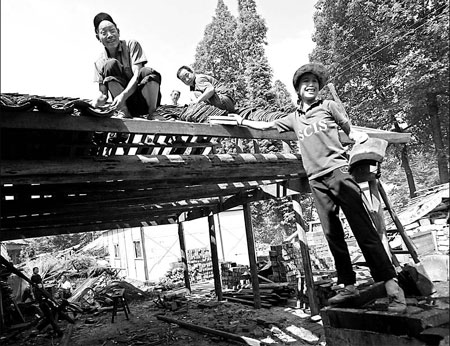
Villagers in Chenjiaba of Beichuan county, Sichuan province, rebuild their damaged homes yesterday.
The country's fast-expanding urban areas can avoid a massive loss of lives as long as structures adhere strictly to its quake-proof building guidelines and construction standards, experts have said.
The guidelines and standards are comparable to those of countries that are experienced in handling quakes, Mao Qishou, a construction professor at Tsinghua University, said on the sidelines of a urban development roundtable yesterday in Beijing.
A building requirement for dealing with quakes, established in 1966, was revised after a 7.8-magnitude tremor hit Tangshan in 1976. It was revised again in 1989 and 2001.
"Even buildings in urban areas that were constructed in the 1980s in line with the aseismatic standards of that period could have possibly avoided the huge loss of lives in the Sichuan quake of May 12," Mao said.
Still, these standards are far from being totally implemented in the country's rural areas, he added.
As part of measures to handle quakes, the Ministry of Construction published a regulation for the management of urban planning on earthquake resistance in 2003.
The regulation requires all cities exposed to tremors with magnitudes above 6 to consider earthquake prevention measures.
For example, Beijing is required to carry out quake-proof planning, with all its buildings designed and constructed to prepare for quakes of 8 magnitude and above.
A reference map by the China Earthquake Administration also shows that cities located near the mountains in central China, Yanshan Mountain and the edge of the Qinghai-Tibet Plateau are required to do the same.
Similarly, Beijing, with a population of about 18 million, has parks and green spaces that can serve as emergency shelters.
More than 140 locations can be used as emergency shelters.
The municipal government has said that it aims to have such shelters within reach of residents in 10 minutes.
Many have voiced concern that rapid urbanization in the country could pose major challenges to cities' abilities to deal with quakes.
A report on China's urban competitiveness published in March by the Chinese Academy of Social Sciences forecast that there will be 1,000 cities and up to 2,000 small towns by the year 2030.
The growth will lead to a high density of population, traffic and economic activity.
When an earthquake occurs, the damage will no longer be limited to the collapse of houses.
Such damage could spread to the commercial and social spheres, Gao Jianguo, a researcher with the China Earthquake Administration's Institute of Geology, was quoted by Xinhua News Agency as saying.
Gao's study showed that more than 70 cities have experienced devastating earthquakes within 50 km, accounting for 10 percent of China's total cities.
(China Daily July 17, 2008)